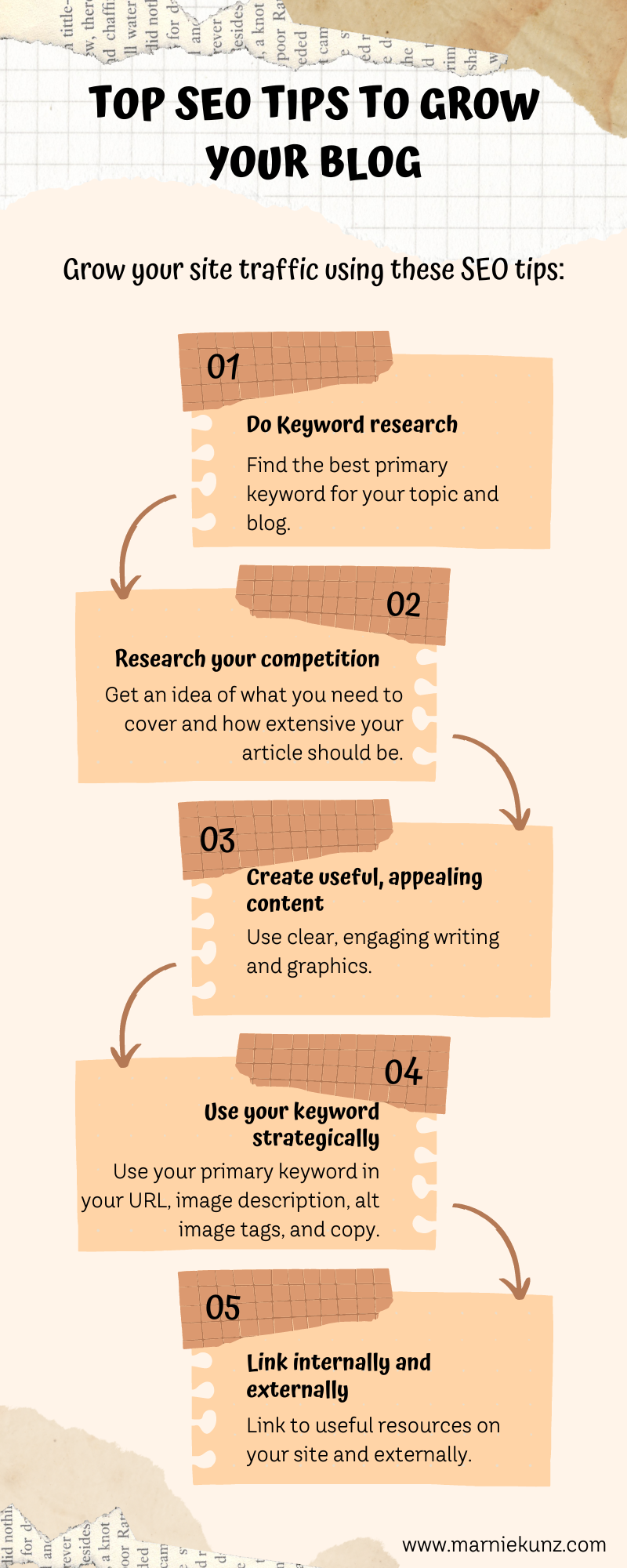My Top SEO Tips to Grow Your Blog
My top SEO tips to grow your blog will help you increase your site traffic and reach. Photo by Sincerely Media.
By Marnie Kunz
After years of practice and study, these are my top SEO tips to grow your blog. I’ve used these strategies to exponentially grow my blog, Runstreet, as well as my clients’ blogs. Since the pandemic hit, I’ve taken several SEO courses that have helped me greatly improve my SEO skills. I’ve also written hundreds of SEO articles for other peoples’ blogs. I love writing and have a background in journalism, which has helped me with writing SEO content.
I wanted to share my top SEO tips for growing your blog because my clients have a lot of confusion about SEO and I would like to offer a strategy to help. There is a lot of conflicting information out there, and these SEO tips offer you some basic guidelines to build upon.
What Is SEO?
First, let’s take a look at what SEO is. SEO stands for Search Engine Optimization, which means improving your ranking in search engines to help your website get more search traffic. The more you are able to gain visibility in searches, the better chances you have of making revenue from ads, affiliate links, or direct business. Whether you have a local restaurant or a blog about movies, everyone can benefit from having more website traffic from search engines.
My Top SEO Tips to Grow Your Blog
Keyword Research
Do your keyword research. Keyword research can be its own separate blog, but basically, you want to use a useful keyword tool to do your research. I use Moz keyword explorer and have found it invaluable for helping my site rank higher in Google searches as well as helping my clients’ sites rank with keywords. When you do keyword research, you are trying to find the best primary keyword phrase which people use to find information on your topic. For instance, if you have a restaurant in downtown Manhattan, you will want to research keywords like “NYC restaurants,” “Soho cafes,” etc. I will do another post to explain more about keywords but generally, look for a keyword that has a high amount of traffic and low competition. Of course, there are many middle-ground areas and if you are just starting with your website or blog, you will want to target lower-ranking keywords as you build your traffic and Domain Authority. (You can check your Domain Authority and learn more here).
Research your Competition
Check the first sites that come up when you Google your target keyword phrase. See what topics they cover, how their articles look, any informative graphics or sidebars, and check out the length of their articles. A good general rule of thumb is to write at least 500 words for your blog post, with 1,000 words being the gold standard and the most common length of the top-ranking blogs. Of course, blog length and depth may vary depending on your niche, so checking out your competitors will give you ideas of what you need to do to beat them.
Create Useful, Appealing Content
Providing the best quality content is one of my top SEO tips to grow your blog. It sounds logical, but you'd be surprised how many people lose sight of the purpose of their blog posts. This is not a game to beat Google but a way to provide people with useful information.
If you want people to come to your site for help, you need to provide value. Create useful, clear content using your keyword phrase. Include visually appealing graphics and photos and break down your content with subheads, bullet points, and lists when applicable.
Use Your Keyword Strategically
This is a big one that is often misunderstood. In general, you want to focus on your primary keyword and up to one or two secondary keywords. Many people think the more the better when it comes to keywords, but if you try to use 10 or 20 keywords, you won’t rank for most of them, and you run the risk of having content that sounds choppy, unnatural, and spammy. This is not helpful to searchers and may penalize you in searches.
A good rule of thumb when it comes to keywords is to use your primary keyword once every 200 words on average. This translates to having your main keyword 10 to 20 times in a 1,000-word article.
Include your primary keyword in the following places:
URL. Place your main keyword phrase in hyphenated form in your URL. So your URL will read like this: www.mywebsite.com/blog/keyword-phase-here.
Title. Include your primary keyword in the title of your blog, preferably close to the beginning of your title.
Subhead. Include your keyword in a subhead in your blog.
Image Names. Name your image files your keyword in hyphenated form. So your photos will have the file name keyword-phrase-here.
Alt Image Tags. Include your keyword in alt image tags in hyphenated form, the same as your image file name.
Link Internally and Externally
Linking high-authority, high-quality sites is another one of my top SEO tips to grow your blog. Include at least one external link on your site. Good sites to link to include government sites, educational institutions and academic research, official studies and polls, and other high-ranking sites that lend credibility to your post.
Link internally to your related posts as well. When you’re writing a blog, you can link a few of your relevant posts or web pages. For instance, if you are discussing healthy eating tips, you may want to link to a healthy recipe for chicken that you have on your site.
Use Great Graphics
People are very visual, and it helps keep them on your site if your posts and site look appealing. Choose great photos that are high-quality. I recommend adding informative graphics if you can. I use Canva Pro to design engaging graphics for my Runstreet blog. Canva offers thousands of useful, beautiful templates for infographics, social media posts, logos, and more that you can tweak by changing the colors and graphics to suit your site style.
Spread the Word
Publishing your blog post is only half the battle. You will build more traffic and Domain Authority by posting links to your blog on high-ranking sites like social media. I have found Pinterest the most helpful for driving traffic to my blog, with Facebook and Twitter coming in next. Even though my Instagram is the biggest social network I have, I generally do not get a lot of blog traffic from Instagram.
Monitor Your Analytics
You can adjust your SEO strategy as needed by evaluating your site analytics. For instance, I was able to see that 95 percent of my site traffic comes from Google and that Pinterest drives the most traffic of the social media sites when I checked my blog analytics. This helped me adjust my social media strategy to focus more on Pinterest. Also, check out your top posts and keywords and generate some ideas for new related content that can help you continue to grow your site traffic.
I hope my top SEO tips to grow your blog have been useful to you. If you need SEO writing help, drop me an email and I’d be happy to give you a quote. Happy creating to you, and best of luck with your site.🤓
Related Posts: My Top Blogging Tips from Over 10 Years of Writing, Blogging Resources
This post includes affiliate links. This means that if I’ve used a product or service and liked it, and that product or service has an affiliate program, I sign up for it. Then, when I mention that product or service in a blog or email, I link to it using an affiliate link and get commission from any sales made from the link, at no extra cost to you. I only do this for companies and services we’ve tested and recommend.
Marnie Kunz is a writer and marketing professional based in Brooklyn, New York. She has a background in small business, journalism, and digital marketing, and is the founder of Runstreet and the Book of Dog.



